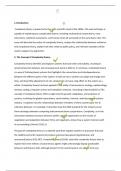���
1.Introduction ���
Complexity theory is poised to be the main scientific trend of the 1990s. This new technique is
capable of explaining any complicated system, including multinational corporations, mass
extinctions, rainforest ecosystems, and human mind. All are based on the same basic rules. The
essay will describe the notion of complexity theory, analyze the relationship between resilience
and complexity theory, explain how they relate to public policy, and relevant examples will be
used to support my arguments.
2. The Concept of Complexity theory.
Complexity theory identifies and explains systems that lack order and stability, resulting in
universal laws for behavior and consequences( Cainery 2012:1). In summary, complexity theory
is a way of thinking about systems that highlights the connections and interdependencies
between the different parts of the system. It looks at how a system can adapt and change over
time, and how little adjustments to one component can have a big effect on the system as a
whole. Complexity theory has been applied to the study of neuroscience, ecology, epidemiology,
memory coding, computer science and metabolic networks. According to Bonnici(2015:1) The
concept of complexity theory offers insight into the growth, adaptation, and evolution of
systems, including the global corporations, stock markets, internet, and telecommunications
industry. It explains how the relationships between members of these systems give rise to
collective behavior. For example, it describes how the GSM standard for the industry arose
from exchanges between competing telecommunications corporations. Complexity, as in the
interactions between business divisions within a global organization or the rounds of
negotiation and adaptation between firms and regulators, shows how a system interacts with
its surroundings ( Bonnici 2015:1).
The goal of complexity theory is to identify (and then explain) systems or processes that lack
the stability and order required to produce universal laws governing behaviour and
outcomes(Cainery 2012:347). Complexity theory (2024), state that complexity theory aims to
explain how even millions of autonomous agents might unknowingly display predictable
behavior and features that, although present in the overall system, are absent from any
, individual component of that system. The idea was developed in response to researchers'
attempts to explain large-scale, complex systems' behavior, which they felt could not be
explained by the standard laws of nature. It looks for patterns in how a system's numerous,
seemingly unrelated components interact to form the system and its results, as well as how
those interactions change over time. It's also one method to convey the idea that systems
dominate many lesser influences ( Complexity theory 2024). There is no master controller in
any system, which is an important concept in complexity theory. Rather, coherent system
behavior is formed by the constant competition and cooperation among players. Another
fundamental aspect of complexity theory is the premise that there are principles behind all
"emergent properties," or features that develop from interactions between many diverse
agents ( Complexity theory 2024).
3.Complexity Theory and the Public Policy Literature.
The literature on complexity and public policy is divided into two main categories: (a) a
relatively narrow subset of studies that analyze public policy directly and explicitly using
complexity theory, arguing that policymaking systems are complex systems (i.e., complexity is
not just another metaphor from natural science); and (b) a much wider subset of studies that
are essential to the public policy literature but highlight characteristics of complex systems
without necessarily using the language of complexity(Cairney 2012).
3.1.Policy-Making Systems are Complex Systems.
According to Cairney(2012) Policymakers face difficulties when they fail to acknowledge the
complexity of their policy contexts, as highlighted by complexity theory. The quest of "human
order" is connected by Geyer and Rihani (2010: 29) to a number of failed attempts to govern
society, such as socialism in the Soviet Union, the Third World's pursuit of a free market
ideology, and "the 1980s and 1990s emphasis on 'centralised public management.They do not
point out that political regimes are totally devoid of law or order. Cairney (2012) imply that
decision-makers in the UK are influenced by the concept of order, which is connected to
government and popular approaches to policy. As a result, the public sector has started to
embrace concepts from the corporate sector and emphasize rigid structures and top-down




